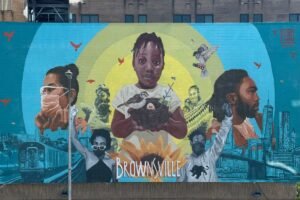
“You can’t build wealth for Black, Indigenous, and other communities of color by continuing to extract wealth from these same communities that have faced multigenerational exclusion and extraction from our financial systems.”
I’ve said this line more times than I can count in meetings with foundations, impact investors, and progressive asset managers. But I’m regularly met with blank stares.
How might we reimagine [fiduciary duty] to pave the path to more just outcomes?
Each time, I feel that maybe this one time, they’ll understand what I’m asking them to consider—that asking for a “market rate” return with community investments is counterproductive. More than considering accepting below-market “concessionary returns,” foundations and impact investors should be thinking about how to return capital to Black and Indigenous communities to account for generations of extracted capital, labor, and land.
Typically, though, I’m met with a hard line: “Our target return on investments cannot be below [insert random positive percentage here], and it’s our fiduciary duty to ensure that we invest our capital with the expectation of a financial return.”
When I first started raising impact capital for community investments, I was struck by how often fiduciary duty would be the block. Most shrugged and said that it was near-impossible without a funder or investor willing to take a radically different approach.
A radically different approach would mean being open to confronting society’s capital bias. As Marjorie Kelly defines this, it is our bias toward the maximum increase of capital, with maximum benefit to wealth holders. While I’m on board for dismantling our society’s capital bias, when confronted with fiduciary duty as the barrier, I wonder, how might we reimagine this concept to pave the path to more just outcomes?
What Are the Roles of a Fiduciary?
Before we throw anything away, it’s useful to understand the purpose of fiduciary duty and see what can be salvaged to orient toward community investment goals. Fiduciary duty clarifies the responsibility of a person who holds a legal or ethical relationship with another individual or institution to manage assets with a duty of care, impartiality, and loyalty—typically, for the benefit of the individual or institution. The duties are defined as:
- Duty of Care
A fiduciary should give the same care and attention to the matters of the individual or institution they represent as they would their own.
- Duty of Impartiality
A fiduciary should treat all beneficiaries—current and potential future beneficiaries—equally. Decisions must be weighed to ensure equal treatment of all beneficiaries.
- Duty of Loyalty
A fiduciary should put the interests of whomever or whatever they are representing ahead of their own personal interests.
These three seemingly straightforward duties ensure fair stewardship. However, when interpreted in traditional ways, they often privilege the preservation of institutions instead of the long-term sustainability of society.
I’m not the first one, nor will I be the last, to observe how financial and wealth-holding institutions, endowments, and asset managers accumulate capital through the extraction of labor, time, and money—specifically from communities of color. So, if the current interpretation of fiduciary duty leads to bad outcomes, how might it be redefined to support community building goals?
Fiduciary Duty Reconsidered
Blueprints for shifting the definitions of fiduciary duty to expand it beyond the preservation of an institution at any cost have already been developing.
How might fiduciary duty be redefined? Offered below are a few new definitions for our fiduciary duties to begin on this pathway to envisioning a better way to invest resources back into communities that have seen active disinvestment and extraction.
Sign up for our free newsletters
Subscribe to NPQ's newsletters to have our top stories delivered directly to your inbox.
By signing up, you agree to our privacy policy and terms of use, and to receive messages from NPQ and our partners.
- Duty of Community Care
A fiduciary should give the same care and attention to the matters of the individual or institution they represent as they would the communities they seek to support or are operating within.
This reorientation shifts investment advisors to see the interests and benefits of institutions and community members on the same level. When managing assets, the duty of community care would compel investors to consider ways to reduce negative effects (externalities) of investments and increase tangible benefits for stakeholders.
A duty of community care would restrain capital accumulation to ensure community wealth building and wellbeing. This duty can show up in structuring community-led funds to ensure that investment terms match the pace at which capital can be deployed.
- Duty of Partiality to Impacted Communities
A fiduciary should remain partial to and ensure greater benefits are accrued to communities impacted by the institution historically and in the present.
As is well known, equity requires acknowledging differences—and taking conscious steps to address disparate treatment. Shifting from a duty of impartiality to a duty of partiality to impacted communities gives investment advisors space to recognize the legacy of colonialism and slavery, as well as how capital and financial institutions have destabilized Black communities, Indigenous communities, and other communities of color. Putting this principle into practice requires shifting from a stance of considering “What is the risk of making an investment?” to “What is the risk of not making an investment?”
- Duty of Loyalty to Community
A fiduciary should put the interests of disinvested communities over the institution and themselves.
A mandate like this could lead investment advisors to think differently about who needs to be holding power within institutions to ensure that community benefits have primacy. We’ve seen a few institutions think critically about how to share power with communities they seek to support by adding them to governance structures.
And what if foundations went further to fully cede power and governance of large asset bases to community members that have been directly or indirectly impacted by an institution’s activities? There are many ways that loyalty to community can be institutionalized, but the one thing that holds true is that these community members must be a part of decision-making for their interests to be prioritized.
Breaking free from common misconceptions of how assets are managed and to what end enables new possibilities to emerge.
How Do We Get There?
Reorienting fiduciary duty is not as far away as it seems—blueprints for shifting the definitions of fiduciary duty to expand it beyond the preservation of an institution at any cost have already been developing. Groups like Chordata Capital and Resource Generation are thinking critically about their fiduciary duty to community care, specifically how to divest accumulated wealth in responsible and community-centered ways. There are also groups that are building perpetual purpose trusts, like Patagonia Purpose Trust or Kensington Corridor Trust, that reframe for whom firms seek financial and nonfinancial returns. The examples of how to push beyond narrow thinking into a more habitable and hospitable world are expanding rapidly.
To build mass momentum around this requires collaboration and partnership between funders/investors, intermediaries, and practitioners—and there is a role for everyone along the way to creating this shift.
- Practitioners, show what is possible. Redefine the investment norms to center community wealth and wellbeing, as defined by having enough to thrive. Build structures and solutions to address the challenges your communities face, even if they do not meet mainstream investment ideology. Create new definitions for what successful community investment actually looks like—to help intermediaries challenge the roles of fiduciaries.
- Intermediaries, redefine the rules of a fiduciary. Keep capital flowing to practitioners who are centering community benefits while simultaneously showing how the new rules of fiduciary duty can be put into practice. Be explicit in naming how you are embodying the duties of community care, partiality to impacted communities, and loyalty to community. Become the models and case studies for funders and investors to act differently.
- Funders and investors, take small actions to ensure larger ones follow. Listen, learn, and try something different—even with a small pool of money at first. Engage your decision-makers in these new definitions of fiduciary responsibility and how they can better support the mission. Seek ways to institutionalize these new definitions to ensure that we are building in alignment with our intermediaries and practitioners.
Breaking free from common misconceptions of how assets are managed and to what end enables new possibilities to emerge that can help move society toward a more equitable economy. However, it will require intentionality to move in this direction of questioning the status quo that dominates the financial sector; illuminating the fallacies; and pointing to solutions of repair, then regeneration, and finally sustainability for people and the planet.
The framework of fiduciary duty is already under challenge. What might people create using a reoriented framework that centers humanity?








